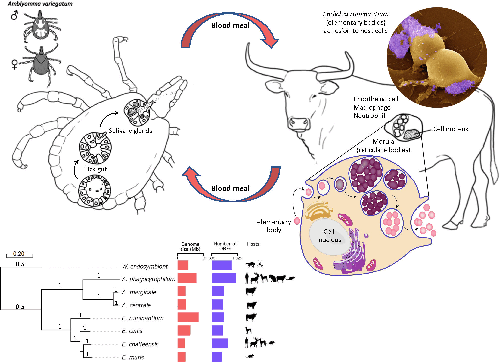
Full text loading...
Summary of Ehrlichia ruminantium infection. E. ruminantium bacterium is typically spread to ruminants by bite from infected ticks. Following adhesion of infectious elementary bodies to host cell, E. ruminantium establishes the depicted intracellular biphasic lifestyle by the means of secreted effector proteins that hijack host cellular pathways. Replicating bacteria (reticulate bodies) fill a large cytoplasmic vacuole named morula inside mammalian or tick cells. Formation of this vacuole is critical for bacterial development and subsequent lysis of the host cell leading to the establishment of heartwater disease. Genetic diversity is one remarkable and biologically significant feature of pathogens in the Anaplasmataceae family, including E. ruminantium . The maximum-likelihood phylogenetic tree of four representative species of Ehrlichia ( E. chaffeensis str. Arkansas, E. canis str. Jake, E. muris AS145, E. ruminantium str. Gardel) with Wolbachia endosymbiont of D. melanogaster as an outgroup was reconstructed on the basis of concatenated nucleic acid alignment of proteins shared by all species (core genomes) with 100 bootstrap resamplings. Major hosts of these bacteria are indicated. Mb, megabase. ORFs, open reading frames. (All images created by S. Mateus, C. Noroy. O. Gros and D.F. Meyer.)
Ehrlichia ruminantium is an obligate intracellular pathogenic bacterium that causes heartwater, a fatal disease of ruminants in tropical areas. Some human cases have also been reported. This globally important pathogen is primarily transmitted by ticks of the Amblyomma genus and threatens American mainland. E. ruminantium replicates within eukaryotic mammal or tick cell is a membrane-bound vacuole, where it undergoes a biphasic developmental growth cycle and differentiates from noninfectious replicative form into infectious elementary bodies. The ability of E. ruminantium to hijack host cellular processes and avoid innate immunity is a fundamental, but not yet fully understood, virulence trait of this stealth pathogen in the genomic era.